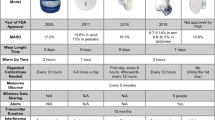Summary
Patch-clamp and single cell [Ca2+] i measurements have been used to investigate the effects of the potassium channel modulators cromakalim, diazoxide and tolbutamide on the insulin-secreting cell line RINm5F. In intact cells, with an average cellular transmembrane potential of −62±2 mV (n=42) and an average basal [Ca2+] i of 102±6nm (n=37), glucose (2.5–10mm): (i) depolarized the membrane, through a decrease in the outward KATP current, (ii) evoked Ca2+ spike potentials, and (iii) caused a sharp rise in [Ca2+] i . In the continued presence of glucose both cromakalim (100–200 μm) and diazoxide (100 μm) repolarized the membrane, terminated Ca2+ spike potentials and attenuated the secretagogue-induced rise in [Ca2+] i . In whole cells (voltage-clamp records) and excised outside-out membrane patches, both cromakalim and diazoxide enhanced the current by opening ATP-sensitive K+ channels. Diazoxide was consistently found to be more potent than cromakalim. Tolbutamide, a specific inhibitor of ATP-sensitive K+ channels, reversed the effects of cromakalim on membrane potential and KATP currents.
Similar content being viewed by others
References
Altszuler, N., Hampshire, J., Morarv, E. 1977. On the mechanism of diazoxide-induced hyperpolarisation.Diabetes 26: 931–935
Ashcroft, F.M. 1988. Adenosine 5′-triphosphate sensitive potassium channels.Annu. Rev. Neurosci. 11: 97–118
Ashcroft, F.M., Harrison, D.E., Ashcroft, S.J.H. 1984. Glucose induces closure of single potassium channels in isolated rat pancreatic B-cells.Nature (London) 312: 446–448
Ashcroft, F.M., Kakei, M., Kelly, R.P., Sutton, R. 1987. ATP-sensitive K+ channels in human isolated pancreatic B-cells.FEBS Lett. 215: 9–12
Byerly, L., Hagiwara, S. 1982. Calcium currents in intracellularly perfused nerve cell bodies ofLimnea stagalis.J. Physiol. (London) 322: 503–528
Cook, N.S. 1988. The pharmacology of potassium channels and their therapeutic potential.Trends Pharmacol. Sci. 9: 21–28
Cook, D.L., Hales, C.N. 1984. Intracellular ATP directly blocks K+ channels in pancreatic B-cells.Nature (London) 311: 271–273
Cook, N.S., Quast, U., Weir, S.W. 1988. In vitro and in vivo comparison of two K+ channel openers, diazoxide and BRL 34915.Pfluegers Arch. 411: R49
Dunne, M.J. 1989. Protein phosphorylation is required for diazoxide to open ATP-sensitive potassium channels in insulin (RINm5F) secreting cells.FEBS Lett. 250: 262–266
Dunne, M.J., Aspinall, R.J., Petersen, O.H. 1990. The effects of cromakalim on ATP-sensitive postassium channels in insulinsecreting cells.Br. J. Pharmacol. 99: 169–175
Dunne, M.J., Bullett, M.J., Li, G., Wollheim, C.B., Petersen, O.H. 1989. Galanin activates nucleotide-dependent K+ channels in insulin-secreting cells via a pertussis toxin-sensitive G-protein.EMBO J. 8: 412–420
Dunne, M.J., Findlay, I., Petersen, O.H. 1988a. Effects of pyridine nucleotides on the gating of ATP-sensitive potassium channels in insulin-secreting cells.J. Membrane Biol. 102: 205–216
Dunne, M.J., Findlay, I., Petersen, O.H., Wollheim, C.B. 1986. ATP-sensitive K+ channels in an insulin-secreting cell line are inhibited byd-glyceraldehyde and activated by membrane permeabilization.J. Membrane Biol. 93: 271–279
Dunne, M.J., Ilott, M.C., Petersen, O.H. 1987. Interactions of diazoxide, tolbutamide and ATP4− on nucleotide-dependent K+ channels in an insulin-secreting cell line.J. Membrane Biol. 99: 215–224
Dunne, M.J., Petersen, O.H. 1989. Ion channels in insulin-secreting cells; their role in stimulus-secretion coupling.In: Epithelial Secretion of Water and Electrolytes. J.A. Young and P.Y.D. Wong, editors. Springer-Verlag, W. Germany(in press)
Dunne, M.J., West-Jordan, J.A., Abraham, R.J., Edwards, R.T.H., Petersen, O.H. 1988b. The gating of nucleotide-sensitive K+ channels in insulin-secreting cells can be modulated by changes in the ratio ATP4−/ADP3− and by nonhydrolyzable derivatives of both ATP and ADP.J. Membrane Biol. 104: 165–172
Escande, D., Thuringer, D., Leguern, S., Cavero, I. 1988. The potassium channel opener cromakalim (BRL 34915) activated ATP-dependent K+ channels in isolated cardiac myocytes.Biochem. Biophys. Res. Commun. 154: 620–625
Faivre, J.-J., Findlay, I. 1989. Effects of tolbutamide, glibenclamide and diazoxide upon action potentials recorded from rat ventricular muscle.Biochim. Biophys. Acta. 984: 1–5
Fenwick, E.M., Marty, A., Neher, E. 1982. Sodium and calcium channels in bovine chromaffin cells.J. Physiol (London) 331: 599–635
Findlay, I., Dunne, M.J. 1986. ATP maintains ATP-inhibited K+ channels in an operational state.Pfluegers Arch. 407: 238–240
Findlay, I., Dunne, M.J., Petersen, O.H. 1985. ATP-sensitive inward rectifier and voltage- and calcium-activated K+ channels in cultured pancreatic islet cells.J. Membrane Biol. 88: 165–172
Grynkiewicz, G., Poenie, M., Tsien, R.Y. 1985. A new generation of Ca2+ indicators with greatly improved fluorescence properties.J. Biol. Chem. 260: 3440–3450
Halban, P.A., Praz, G.A., Wollheim, C.B. 1983. Abnormal glucose metabolism accompanies failure of glucose to stimulate insulin release from a pancreatic cell line (RINm5F).Biochem. J. 212: 439–443
Hamill, O.P., Marty, A., Neher, E., Sakmann, B., Sigworth, F.J. 1981. Improved patch-clamp techniques for high resolution current recordings from cells and cell-free membrane patches.Pfluegers Arch. 391: 85–100
Hamilton, T.C., Weir, S.W., Weston, A.H. 1986. Comparison of the effects of BRL 34915 and verapamil on electrical and mechanical activity in rat portal vein.Br. J. Pharmacol. 88: 103–111
Henquin, J.C. 1980. Tolbutamide stimulation and inhibition of insulin release: Studies of the underlying ionic mechanism in isolated rat islets.Diabetologia 18: 151–160
Henquin, J.C., Charles, S., Nenquin, M., Mathat, F. 1982. Diazoxide and D600 inhibition of insulin release. Distinct mechanisms explain the specificity for different stimuli.Diabetes 31: 776–783
Henquin, J.C., Meissner, H.P. 1982. Opposite effects of tolbutamide and diazoxide on86Rb fluxes and membrane potential in mouse pancreatic B-cells.Biochem. Pharmacol. 31: 1407–1413
Katayama, M., Hofmann, F., Trautwein, W. 1985. On the mechanism of beta-adrenergic regulation of the Ca channel in the guinea pig heart.Pfluegers Arch. 405: 285–293
Matthews, E.K., Sakamoto, Y. 1975. Electrical characteristics of pancreatic islet cells.J. Physiol. (London) 246: 421–437
Petersen, O.H. 1988. Control of potassium channels in insulin-secreting cells.ISI Atlas Sci. (Biochem.) 1: 144–149
Petersen, O.H., Dunne, M.J. 1989. Regulation of K+ channels plays a crucial role in the control of insulin secretion.Pfluegers Arch. 414: S115-S120
Petersen, O.H., Findlay, I. 1987. Electrophysiology of the pancreas.Physiol. Rev. 67: 1054–1116
Praz, G.A., Halban, P.A., Wollheim, C.B., Blondel, B., Strauss, A.J., Renold, A.E. 1983. Regulation of immunoreactive-insulin release from a rat cell line (RINm5F).Biochem J. 210: 345–352
Quast, U., Cook, N.S. 1989. In vitro and in vivo comparison of two K+ channel openers, diazoxide and cromakalim, and there inhibition by glibenclamide.J. Pharmacol. Exp. Ther. 250: 261–271
Ribalet, B., Eddlestone, G.T., Ciani, S. 1988. Metabolic regulation of the K(ATP) and a K(MAXI) channel in the insulin-secreting RINm5F cell.J. Gen. Physiol. 92: 219–237
Rorsman, P., Arkhammar, P., Berggren, P.-O. 1986. Voltage-activated Na+ currents and their suppression by phorbol ester in clonal insulin-producing RINm5F cells.Am. J. Physiol. 251: C912-C919
Rorsman, P., Trube, G. 1985. Glucose-dependent K+ channels in pancreatic B-cells are regulated by intracellular ATP.Pfluegers Arch. 405: 305–309
Sanguinetti, M.C., Scott, A.L., Zingaro, G.J., Siegl, P.K.S. 1988. BRL 34915 (cromakalim) activates ATP-sensitive K+ current in cardiac muscle.Proc. Nat. Acad. Sci USA 85: 8360–8364
Schlegel, W., Winiger, B.P., Mollard, P., Voucher, P., Warnin, F., Zahnd, G.R., Wollheim, C.B., Dufy, B. 1987. Oscillations of cytosolic Ca2+ in pituitary cells due to action potentials.Nature (London) 329: 719–721
Schlegel, W., Winiger, B.P., Warnin, F., Zahnd, G.R., Wollheim, C.B. 1988. Monitoring receptor mediated regulation of cytosolic calcium in single pituitary cells by dual excitation microfluorimetry.J. Recept. Res. 8: 493–507
Schmid-Antomarchi, H., De Weille, J., Fosset, M., Lazdunski, M. 1987. The antidiabetic sulphonylurea glibenclamide is a potent blocker of ATP-modulated K+ channels in insulin-secreting cells.Biochem. Biophys. Res. Commun. 146: 21–25
Shetty, S.S., Weiss, G.B. 1987. Dissociation of actions of BRL 34915 in the rat portal vein.Eur. J. Pharmacol. 141: 485–488
Standen, N.B., Quayle, J.M., Davies, N.W., Brayden, J.E., Huang, Y., Nelson, M.T. 1989. Hyperpolarizing vasodialators activate ATP-sensitive K+ channels in arterial smooth muscle cells.Science 245: 177–180
Trube, G., Rorsman, P., Ohno-Shosaku, T. 1986. Opposite effects of tolbutamide and diazoxide on the ATP-dependent K+ channel in mouse pancreatic B-cells.Pfluegers Arch. 407: 493–499
Velasco, J.M., Petersen, J.U.H., Petersen, O.H. 1988. Single-channels Ba2+ currents in insulin-secreting cells are activated by glyceraldehyde stimulation.FEBS Lett. 231: 366–370
Wollheim, C.B., Biden, T.J. 1987. Signal transduction in insulin secretion: Comparison between fuel and receptor agonist.Ann. NY Acad. Sci. 488: 317–333
Yule, D.I., Gallacher, D.V. 1988. Oscillations of cytosolic calcium in single pancreatic acinar cells stimulated by acetylcholine.FEBS Lett. 239: 558–562
Author information
Authors and Affiliations
Rights and permissions
About this article
Cite this article
Dunne, M.J., Yule, D.I., Gallacher, D.V. et al. Comparative study of the effects of cromakalim (BRL 34915) and diazoxide on membrane potential, [Ca2+] i and ATP-sensitive potassium currents in insulin-secreting cells. J. Membrain Biol. 114, 53–60 (1990). https://doi.org/10.1007/BF01869384
Received:
Revised:
Issue Date:
DOI: https://doi.org/10.1007/BF01869384




